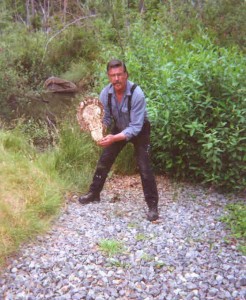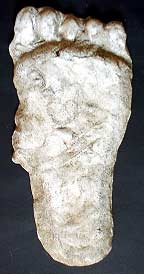First Bigfoot Investigator Was Crook?
Posted by: Loren Coleman on January 28th, 2010

The man that gave Bigfoot history the above image is back. After retiring, and allegedly selling most of his collection on eBay, Cliff Crook has resurfaced. I guess to some Bigfooting to them is as football is to Brett Favre.
The following article promotes Cliff Crook as “America’s First Bigfoot Investigator,” a claim that would be difficult to document considering others who were examining evidence for hairy bipedal hominoids in North America before 1956. Furthermore, it shows a new drift to Crook’s work into the world of creationism, and the human-like footprints allegedly found near dinosaur tracks along the Paluxy River, near Glen Rose, Texas.
This is indeed an unfortunate new direction for Crook.

Here’s an excerpt:
‘America’s first Bigfoot investigator’ finds new footprintsSasquatch print: Not everyone agrees with Bothell-area manPublished: 01/27/10By Mike Archbold, The News Tribune, Tacoma, WashingtonOne night 54 years ago, Cliff Crook says, he stared into the face of a Northwest boogeyman. He called it a “woods giant.” Today, it’s better known as Bigfoot.
“I had a real terrifying encounter,” said Crook, now 69. “It’s not something that goes away.”
He remembers the towering size, the ape-like face, the gurgling sound in the dark. He remembers the dog that charged into the bushes and then was tossed out and crashed onto the ground.
He remembers running away with three younger camping buddies. They arrived home a mile away, their bare feet bleeding. His friends’ parents weren’t too happy with him.
“They didn’t want them around me anymore,” Crook recalled last week.
The encounter fueled a lifelong obsession by Crook with the hairy ape-like creature. He calls himself “America’s first Bigfoot investigator.” Others call him a hoaxer and an attention grabber.
Crook appeared on the front page of The News Tribune in 1990 when some mushroom hunters found possible Bigfoot footprints near the Nisqually River. Crook found the prints credible.
He called The News Tribune recently to announce more Bigfoot footprint news, what he called the biggest find in 30 years.
STATUE MOVES DOWNTOWN
The basement den in Crook’s Bothell-area home used to be Bigfoot Central, where over the years he regaled visitors from around the world with stories of his encounter and the investigations into sightings, footprints and efforts to find the ape-like creature.
Maps, drawings, newspaper clippings, footprint casts and Bigfoot memorabilia decorated the walls. An 8-foot-tall carved wooden Bigfoot sat on the front lawn to welcome visitors.
The basement is now home to the Doo-Wop Den, a 1950s style café filled with 1950s kitsch and collectibles. The Bigfoot statue graces a market in downtown Bothell.
Crook’s son, Cary, in Polson, Mont., carries on the family research and keeps the Bigfoot Central Web site updated.
Nevertheless, the elder Crook still wears a big metal pinky ring showing the head of sasquatch. (His wife, Carol, gave it to him.) And he’s enthusiastic about new research he says shows Bigfoot’s ancestors once roamed the Texas countryside side by side with dinosaurs.
“There’s never been fossil evidence of Bigfoot,” Crook said.
And now there is, he said, pointing at the casts of two large footprints he’s placed on the den’s black-and-white checked linoleum floor.
One cast, Crook said, is of a footprint he made in 1999 from the rock bed of the Paluxy River, near Glen Rose, Texas. The fossil print, he said, is one of more than a dozen in a row in the river rock, a hot spot for dinosaur footprints from 140 million years ago.
Some creationists say the prints are the tracks of giant humans. Many paleontologists say they belong to dinosaurs and other reptiles, not man or any kind of primate.
The other cast is what Crook calls a credible Bigfoot footprint found in 1991 in Mount Baker-Snoqualmie National Forest near Darrington.
“They’re mirror images,” he said of the two.
Both footprints show four of seven tell-tale signatures he said he has developed over the years to enable him to tell which prints are real and which are fake. He declined to reveal the signatures, saying he did not want people to use them to fake footprints.
Crook calls the tracks Bigfoot’s Fossil Trail and another piece of evidence that the Bigfoot today is no mere legend.
‘BLOWING SMOKE,’ SAYS PROF
Good luck with that idea, says Jeff Meldrum, associate professor of anatomy and anthropology at the University of Idaho in Moscow.
Meldrum, a sasquatch investigator, is generally skeptical of Crook’s footprint claims. Told of the fossil footprint, he was not impressed.
“Since he is talking about Paluxy (River), I am quite certain he is blowing smoke,” Meldrum said in an e-mail. “That area has a long history of footprint discovery, misinterpretation and outright fabrication. …
“The notion that a species of giant bipedal primate existed alongside dinosaurs is baseless, totally without evidence, let alone a reasonable theoretical framework given our understanding of the fossil record.
“If sasquatch exists, it was likely a relic of the trend among many mammal species toward gigantism during the Pleistocene: mammoths, short-faced bear, dire wolf, panda, etc.”
Meldrum focuses his research, writing and lectures on Bigfoot footprints and how they relate to locomotion. Though he has never had an encounter, he says the amount of evidence of Bigfoot, including footprints, convinces him it’s worth investigating.
The News Tribune sent Meldrum a photograph of the Texas fossil cast Crook made next to the cast from near Mount Baker and asked him to comment.
“Nothing from there previously has resembled the (fossil) cast on the right,” he said in reply.
He also challenged the cast itself.
“One can’t simply pour plaster into a fossilized footprint, an imprint in stone, let it harden and then pull it out. The plaster or cement would adhere to the rock without a separator, so there wouldn’t be any flecks of rock in the plaster as evident in the photo.”
Crook dismisses Meldrum’s comments.
“I know this discovery would rattle the bed frames of sleeping science a bit,” he said. “I have rattled a few beds before, but real science is about uncovering the truth. When tracks match, they match.”
Crook defended his cast-making. Using a nonsticking cooking oil allowed him to make the fossil cast, he said. He also produced photographs of himself at the river standing next to the tracks.
He said the purported Bigfoot fossil tracks are different from the so-called “giant man” tracks others say they have found.
To read the end of the article about more of Crook’s past days, not related to the new “findings” of his, see here.
The news photos displayed above were taken by Dean J. Koepfler / Staff photographer of the The News Tribune.
P.S. For those that have examined, in some depth, the other Cliff Crook footcasts from the Hoh Indian Reservation (shown below) and elsewhere, an uncomfortably similar pattern seems apparent from the uneven nature of the toes – and the middle toe being the deepest. The cast above, on the right, said to be from Texas, seems to repeat this pattern. See Zack Clothier’s analysis of this element, also, for example.
About Loren Coleman
Loren Coleman is one of the world’s leading cryptozoologists, some say “the” leading living cryptozoologist. Certainly, he is acknowledged as the current living American researcher and writer who has most popularized cryptozoology in the late 20th and early 21st centuries.
Starting his fieldwork and investigations in 1960, after traveling and trekking extensively in pursuit of cryptozoological mysteries, Coleman began writing to share his experiences in 1969. An honorary member of Ivan T. Sanderson’s Society for the Investigation of the Unexplained in the 1970s, Coleman has been bestowed with similar honorary memberships of the North Idaho College Cryptozoology Club in 1983, and in subsequent years, that of the British Columbia Scientific Cryptozoology Club, CryptoSafari International, and other international organizations. He was also a Life Member and Benefactor of the International Society of Cryptozoology (now-defunct).
Loren Coleman’s daily blog, as a member of the Cryptomundo Team, served as an ongoing avenue of communication for the ever-growing body of cryptozoo news from 2005 through 2013. He returned as an infrequent contributor beginning Halloween week of 2015.
Coleman is the founder in 2003, and current director of the International Cryptozoology Museum in Portland, Maine.















Crook’s claims regarding a hominin-like origin for some of the Paluxy River tracks is not credible. Even highly regarded Institute for Creation Research spokesman John D. Morris, Ph.D., discounted the tracks, noting their dinosaurian or, at best, uncertain origin and the history of misinterpretation. Although he softens his verdict with the typical “continued research is in order” statement often employed by researchers, he concluded that it was “improper for creationists to continue to use the Paluxy data as evidence against evolution.”
http://is.gd/7dHe8
Whatever footprints or other evidence Crook has “found” in the past now become highly questionable and not suitable for scientific purposes.
So he’s the one who took a pic of a toy/little model on a lawn using forced perspective to try to make it look like bigfoot?
The U.S.A. is a strange country.
He got a segment on KOMO-TV, Channel 4 here in the Pac Northwest. His story didn’t sound too convincing, but it was a short segment, with most of it being background.
I wasn’t aware that the upward looking creature picture had been positively identified as a toy.
Meldrum was easily schooled about using cooking oil to separate plaster from stone.
I’m a sculptor and not only cooking oil, but soap, 1/2 alcohal 1/2 baby powder, vaseline, hair grease-etc…will work as separator…
Hey Cliff, You go baby! I think your basement sounds cool too!
FAME! NOTORIETY! PAID TALK-SHOW CAREER. GIRLS GIRLS GIRLS!
Funny, I had just wandered over to his site, by accident, if there’s such a thing. Returned to check Cryptomundo, and there it is! I don’t know if someone is following me, or I’m following them, not sure….
I always thought it looked two-dimensional, like a drawing, much in the style of Frazetta.